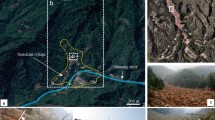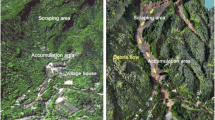Abstract
Rockslide-debris flow may cause catastrophic damages because of its high speed and long run-out distance. The influences of slope gradient and gully channel on the entrainment, deposition, and run-out behavior of this type of landslide were not sufficiently investigated by previous studies. To achieve a better understanding toward this type of landslide, a recent rockslide-debris flow that occurred in the Northern Apennines of Italy is studied through field investigation and numerical simulation. The run-out process of this landslide is simulated by an improved depth-averaged model, paying special attention to analyzing the influence of slope gradient and gully channel. The simulation results are compared with the detailed field data of entrainment and deposition distributions. It shows that the depth-averaged model can reasonably simulate the entrainment and deposition characteristic of this landslide by adopting different basal friction strengths for the rockslide region and debris flow region. Entrainment occurs in both high and low slope gradient zones. However, entrainment can only be observed in the high slope gradient zones, while in the low gradient zones, the post-failure topography shows accumulation and deposition. The simulation results also demonstrate that the presence of a gully channel is a key factor in determining landslide mobility and run-out distance. In comparison to a landslide with similar size and geological settings but without a gully channel, the run-out distance is much less, and the landslide does not develop into a flow.













Similar content being viewed by others
References
Aaron J, McDougall S (2019) Rock avalanche mobility: the role of path material. Eng Geol 257:105126. https://doi.org/10.1016/j.enggeo.2019.05.003
Berti M, Cuzzani MG, Vai GB, Landuzzi A, Taviani M, Aharon P (1994) Hydrocarbon-derived imprints in olistostromes of the Early Serravallian Marnoso-Arenacea Formation, Romagna Apennines (northern Italy). Geo-Mar Lett 14:192–200. https://doi.org/10.1007/BF01203731
Berti M, Genevois R, Ghirotti M, Tecca PR (1996) Mechanical characteristics and behaviour of a complex formation by landslide investigations and analyses. 7th International Symposium on landslides. Balkema, pp 1155–1162
Bowman ET, Take WA, Rait KL, Hann C (2012) Physical models of rock avalanche spreading behaviour with dynamic fragmentation. Can Geotech J 49:460–476. https://doi.org/10.1139/t2012-007
Christen M, Kowalski J, Bartelt P (2010) RAMMS: numerical simulation of dense snow avalanches in three-dimensional terrain. Cold Reg Sci Technol 63:1–14. https://doi.org/10.1016/j.coldregions.2010.04.005
Collins BD, Reid ME (2019) Enhanced landslide mobility by basal liquefaction: the 2014 State Route 530 (Oso), Washington, landslide. GSA Bull 132:451–476. https://doi.org/10.1130/B35146.1
Crosta GB, Frattini P, Fusi N (2007) Fragmentation in the Val Pola rock avalanche, Italian Alps. J Geophys Res Earth Surf 112:F01006. https://doi.org/10.1029/2005JF000455
Cuomo S, Pastor M, Capobianco V, Cascini L (2016) Modelling the space–time evolution of bed entrainment for flow-like landslides. Eng Geol 212:10–20. https://doi.org/10.1016/j.enggeo.2016.07.011
Dai Z, Huang Y, Cheng H, Xu Q (2017) SPH model for fluid–structure interaction and its application to debris flow impact estimation. Landslides 14:917–928. https://doi.org/10.1007/s10346-016-0777-4
Davies TR, McSaveney MJ (2009) The role of rock fragmentation in the motion of large landslides. Eng Geol 109:67–79. https://doi.org/10.1016/j.enggeo.2008.11.004
Dufresne A, Geertsema M (2020) Rock slide–debris avalanches: flow transformation and hummock formation, examples from British Columbia. Landslides 17:15–32. https://doi.org/10.1007/s10346-019-01280-x
Gao G, Meguid MA, Chouinard LE, Zhan W (2021) Dynamic disintegration processes accompanying transport of an earthquake-induced landslide. Landslides 18:909–933. https://doi.org/10.1007/s10346-020-01508-1
Gao Y, Yin Y, Li B, Feng Z, Wang W, Zhang N, **ng A (2017) Characteristics and numerical runout modeling of the heavy rainfall-induced catastrophic landslide–debris flow at Sanxicun, Dujiangyan, China, following the Wenchuan Ms 8.0 earthquake. Landslides 14:1361–1374. https://doi.org/10.1007/s10346-016-0793-4
Ghaïtanellis A, Violeau D, Liu PLF, Viard T (2021) SPH simulation of the 2007 Chehalis Lake landslide and subsequent tsunami. J Hydraul Res 59:863–887. https://doi.org/10.1080/00221686.2020.1844814
Guthrie RH, Friele P, Allstadt K, Roberts N, Evans SG, Delaney KB, Roche D, Clague JJ, Jakob M (2012) The 6 August 2010 Mount Meager rock slide-debris flow, coast mountains, British Columbia: characteristics, dynamics, and implications for hazard and risk assessment. Nat Hazards Earth Syst Sci 12:1277–1294. https://doi.org/10.5194/nhess-12-1277-2012
Hungr O, Evans SG (2004) Entrainment of debris in rock avalanches: an analysis of a long run-out mechanism. GSA Bull 116:1240–1252. https://doi.org/10.1130/B25362.1
Hungr O, Leroueil S, Picarelli L (2014) The Varnes classification of landslide types, an update. Landslides 11:167–194. https://doi.org/10.1007/s10346-013-0436-y
Hungr O, McDougall S (2009) Two numerical models for landslide dynamic analysis. Comput Geosci 35:978–992. https://doi.org/10.1016/j.cageo.2007.12.003
Iverson RM, Ouyang C (2015) Entrainment of bed material by earth-surface mass flows: review and reformulation of depth-integrated theory. Rev Geophys 53:27–58. https://doi.org/10.1002/2013RG000447
Li X, Tang X, Zhao S, Yan Q, Wu Y (2021) MPM evaluation of the dynamic runout process of the giant Daguangbao landslide. Landslides 18:1509–1518. https://doi.org/10.1007/s10346-020-01569-2
Liang H, He S, Liu W (2020) Dynamic simulation of rockslide-debris flow based on an elastic–plastic framework using the SPH method. Bull Eng Geol Environ 79:451–465. https://doi.org/10.1007/s10064-019-01537-8
Mangeney CA, Vilotte JP, Bristeau MO, Perthame B, Bouchut F, Simeoni C, Yerneni S (2003) Numerical modeling of avalanches based on Saint Venant equations using a kinetic scheme. J Geophys Res Solid Earth 108:2527. https://doi.org/10.1029/2002JB002024
McDougall S, Boultbee N, Hungr O, Stead D, Schwab JW (2006) The Zymoetz river landslide, British Columbia, Canada: description and dynamic analysis of a rock slide–debris flow. Landslides 3:195. https://doi.org/10.1007/s10346-006-0042-3
McDougall S, Hungr O (2005) Dynamic modelling of entrainment in rapid landslides. Can Geotech J 42:1437–1448. https://doi.org/10.1139/t05-064
Mergili M, Jaboyedoff M, Pullarello J, Pudasaini SP (2020) Back calculation of the 2017 piz cengalo–bondo landslide cascade with r.Avaflow: what we can do and what we can learn. Nat Hazards Earth Syst Sci 20:505–520. https://doi.org/10.5194/nhess-20-505-2020
O’Brien JS, Julien PY, Fullerton WT (1993) Two-dimensional water flood and mudflow simulation. J Hydraul Eng 119:244–261. https://doi.org/10.1061/(ASCE)0733-9429(1993)119:2(244)
Ouyang C, He S, Tang C (2015) Numerical analysis of dynamics of debris flow over erodible beds in Wenchuan earthquake-induced area. Eng Geol 194:62–72. https://doi.org/10.1016/j.enggeo.2014.07.012
Ouyang C, He S, Xu Q, Luo Y, Zhang W (2013) A Maccormack-TVD finite difference method to simulate the mass flow in mountainous terrain with variable computational domain. Comput Geosci 52:1–10. https://doi.org/10.1016/j.cageo.2012.08.024
Pastor M, Haddad B, Sorbino G, Cuomo S, Drempetic V (2009) A depth-integrated, coupled SPH model for flow-like landslides and related phenomena. Int J Numer Anal Methods Geomech 33:143–172. https://doi.org/10.1002/nag.705
Ricci Lucchi F, Valmori E (1980) Basin-wide turbidites in a Miocene, over-supplied deep-sea plain: a geometrical analysis. Sedimentology 27:241–270. https://doi.org/10.1111/j.1365-3091.1980.tb01177.x
Sassa K, Nagai O, Solidum R, Yamazaki Y, Ohta H (2010) An integrated model simulating the initiation and motion of earthquake and rain induced rapid landslides and its application to the 2006 Leyte landslide. Landslides 7:219–236. https://doi.org/10.1007/s10346-010-0230-z
Sassa K, Wang Gh (2005) Mechanism of landslide-triggered debris flows: liquefaction phenomena due to the undrained loading of torrent deposits. In: Jakob M, Hungr O (eds) Debris-flow hazards and related phenomena. Springer, Berlin Heidelberg, Berlin, Heidelberg, pp 81–104
Shen W, Li T, Li P, Berti M, Shen Y, Guo J (2019a) A two-layer numerical model for simulating the frontal plowing phenomenon of flow-like landslides. Eng Geol 259:105168. https://doi.org/10.1016/j.enggeo.2019.105168
Shen W, Wang D, Qu H, Li T (2019b) The effect of check dams on the dynamic and bed entrainment processes of debris flows. Landslides 16:2201–2217. https://doi.org/10.1007/s10346-019-01230-7
Shen W, Li T, Li P, Guo J (2018) A modified finite difference model for the modeling of flowslides. Landslides 15:1577–1593. https://doi.org/10.1007/s10346-018-0980-6
Shugar DH, Jacquemart M, Shean D, Bhushan S, Upadhyay K, Sattar A, Schwanghart W, McBride S, de Vries MVW, Mergili M, Emmer A, Deschamps-Berger C, McDonnell M, Bhambri R, Allen S, Berthier E, Carrivick JL, Clague JJ, Dokukin M, Dunning SA, Frey H, Gascoin S, Haritashya UK, Huggel C, Kääb A, Kargel JS, Kavanaugh JL, Lacroix P, Petley D, Rupper S, Azam MF, Cook SJ, Dimri AP, Eriksson M, Farinotti D, Fiddes J, Gnyawali KR, Harrison S, Jha M, Koppes M, Kumar A, Leinss S, Majeed U, Mal S, Muhuri A, Noetzli J, Paul F, Rashid I, Sain K, Steiner J, Ugalde F, Watson CS, Westoby MJ (2021) A massive rock and ice avalanche caused the 2021 disaster at Chamoli. Indian Himalaya Science 373:300. https://doi.org/10.1126/science.abh4455
Soga K, Alonso E, Yerro A, Kumar K, Bandara S (2016) Trends in large-deformation analysis of landslide mass movements with particular emphasis on the material point method. Géotechnique 66:248–273. https://doi.org/10.1680/jgeot.15.LM.005
Wang FW, Sassa K, Wang G (2002) Mechanism of a long-runout landslide triggered by the August 1998 heavy rainfall in Fukushima Prefecture, Japan. Eng Geol 63:169–185. https://doi.org/10.1016/S0013-7952(01)00080-1
Wu J-H, Lin W-K, Hu H-T (2018) Post-failure simulations of a large slope failure using 3DEC: the Hsien-du-shan slope. Eng Geol 242:92–107. https://doi.org/10.1016/j.enggeo.2018.05.018
**a X, Liang Q (2018) A new depth-averaged model for flow-like landslides over complex terrains with curvatures and steep slopes. Eng Geol 234:174–191. https://doi.org/10.1016/j.enggeo.2018.01.011
**ng AG, Wang G, Yin YP, Jiang Y, Wang GZ, Yang SY, Dai DR, Zhu YQ, Dai JA (2014) Dynamic analysis and field investigation of a fluidized landslide in Guanling, Guizhou, China. Eng Geol 181:1–14. https://doi.org/10.1016/j.enggeo.2014.07.022
Xu Q, Fan X, Huang R, Yin Y, Hou S, Dong X, Tang M (2010) A catastrophic rockslide-debris flow in Wulong, Chongqing, China in 2009: background, characterization, and causes. Landslides 7:75–87. https://doi.org/10.1007/s10346-009-0179-y
Xu X, ** F, Sun Q, Soga K, Zhou GGD (2018) Three-dimensional material point method modeling of runout behavior of the Hongshiyan landslide. Can Geotech J 56:1318–1337. https://doi.org/10.1139/cgj-2017-0638
Yin Y, Cheng Y, Liang J, Wang W (2016) Heavy-rainfall-induced catastrophic rockslide-debris flow at Sanxicun, Dujiangyan, after the Wenchuan Ms 8.0 earthquake. Landslides 13:9–23. https://doi.org/10.1007/s10346-015-0554-9
Zhang X, Krabbenhoft K, Sheng D, Li W (2015) Numerical simulation of a flow-like landslide using the particle finite element method. Comput Mech 55:167–177. https://doi.org/10.1007/s00466-014-1088-z
Zhang X, Wang L, Krabbenhoft K, Tinti S (2020) A case study and implication: particle finite element modelling of the 2010 Saint-Jude sensitive clay landslide. Landslides 17:1117–1127. https://doi.org/10.1007/s10346-019-01330-4
Acknowledgements
We would like to thank the anonymous referees for carefully reading the manuscript and providing constructive comments to help us improve the quality of this paper.
Funding
This research is funded by the National Key R&D Program of China (2021YFE0111900), the Fundamental Research Funds for the Central Universities, CHD (300102261507), and the China Scholarship Council (CSC) – University of Bologna Joint Scholarship (file no. 201806560011).
Author information
Authors and Affiliations
Corresponding author
Ethics declarations
Conflict of interest
The authors declare no competing interests.
Rights and permissions
About this article
Cite this article
Shen, W., Berti, M., Li, T. et al. The influence of slope gradient and gully channel on the run-out behavior of rockslide-debris flow: an analysis on the Verghereto landslide in Italy. Landslides 19, 885–900 (2022). https://doi.org/10.1007/s10346-022-01848-0
Received:
Accepted:
Published:
Issue Date:
DOI: https://doi.org/10.1007/s10346-022-01848-0




